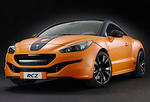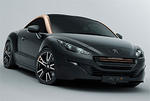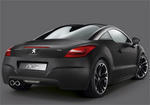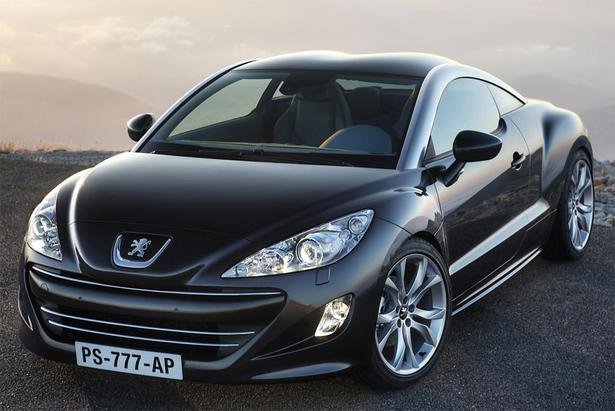
The French carmaker has unveiled its latest model, the Peugeot RCZ, which will be officially unveiled at the Frankfurt auto show next month. The engine options of the Peugeot RCZ includes a 1.6 liter THP unit with 200 bhp, a 1.6 liter THP engine developing 156 bhp and 2.0 liter HDi FAP engine with an output of 163 bhp. The gearbox options offered by the Peugeot RCZ include a six-speed manual and a 6-speed automatic transmission.
The French are offering with the Peugeot RCZ a range of personalization options which include various 18 and 19 inch rims, a real carbon roof, roof arches in different colors carbon door mirror covers and bodywork detailing.
The Peugeot RCZ price has not been announced yet, but the company mentioned the car will go on sale in the spring of 2010.
Peugeot Press Release:
The launch of the Peugeot RCZ will mark the start of a dynamic new chapter in the history of Peugeot. This stunning coupe has been designed to be a special vehicle within the Peugeot range, aimed directly at customers who see their cars as a source of driving enjoyment as well as daily transport.
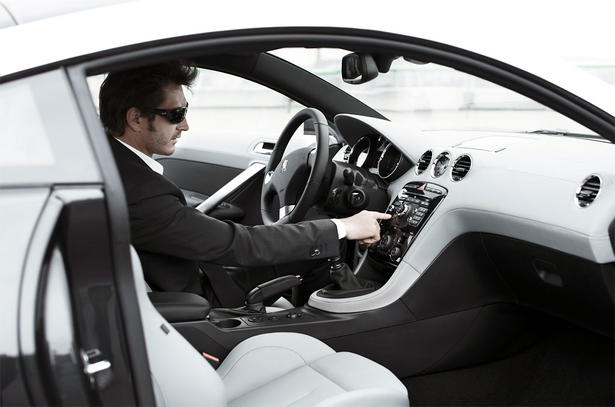
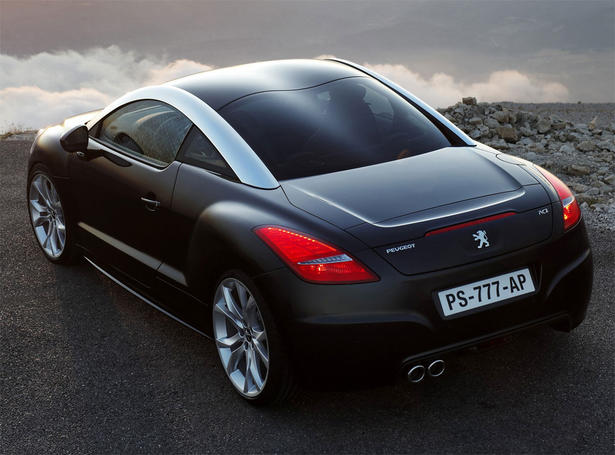
The name, PEUGEOT RCZ, symbolizes this special positioning as it will be the first Peugeot passenger car not to use the traditional numbering system with a central ‘zero’ or ‘double zero’.
Designed to enhance the sheer enjoyment of driving, the Peugeot RCZ is both dynamic (the top of the range model features an all new 1.6 liter THP 200 bhp engine) and responsible, offering an innovative blend of performance and environmental-friendliness. With its reduced weight, fine-tuned aerodynamics and modern engine technology, the entry level model has CO2 emissions of only 139 g/km.
Due to the special nature of the vehicle, it will be built by Magna Steyr in Austria in a production center that specializes in exclusive vehicles built in small volumes.
Styling
The Peugeot RCZ is a compact 2+ 2 Coupe with a number of key styling features. The “double bubble” of the roof, which was a major talking point of the original concept car, is retained in the production car.
The aluminum “roof arches”, another feature of the concept car, are also retained and help highlight the front windscreen, black roof panel and dark-tinted rear windscreen. At the front the Peugeot RCZ retains the marquee’s characteristic feline look.
The vehicle stands 1.36 m high and, with the optimised airflow due to the double bubble roof, has superb aerodynamics. At the rear, an active rear boot spoiler also contributes to the car’s aerodynamic efficiency; it can be deployed in two positions according to the speed of the vehicle to ensure an ideal balance between road holding and fuel consumption.
Interior
The passenger compartment of the Peugeot RCZ instantly immerses the driver in a subtly elitist ambience echoing the world of motor sport.
“Getting into” the vehicle, the driver discovers an ergonomic driving position, ideal for enjoying the Peugeot RCZ’s high levels of road-holding. The wrap-around seats with their integral head restraints fit like a glove around the front occupants, and all the controls are easily within the reach of the driver.
The use of high quality materials throughout the interior combines with the elegant design to enhance the overall premium feeling of the interior.
The instrument panel dials are contained in metal cases, with photo-etched, back-lit markings, a feature which is also continued in the stylish centrally mounted clock.
The fascia panel is covered entirely with an innovative soft feel material, hi-tech in appearance and very elegant in style. Customers will also be able to choose from several different colors. Nappa integral leather trim, a luxurious thick leather with a particularly fine, smooth grain is also available.
The overall ambience of the interior can also be enhanced by a range of hi-tech in-car-entertainment systems - Peugeot Connect 3D multimedia system, JBL™ Hi-fi system, Peugeot Connect USB box ….
The interior is also very versatile, allowing users to adapt to many situations. For example, for a long weekend, the boot offers a capacity of 384 liters (321 dm3 according to the VDA standard) added to which are storage spaces under the boot floor. There is also the potential to increase this capacity further by folding the rear seat backs down.
Finally, it offers two occasional seats, fully sculpted and perfectly usable, especially since the design of the roof with its double bubble offers extra headroom to these occasional rear passengers.
In the Peugeot RCZ, good looks combine with practicality…
Power-train options
At launch in 2010, three engines will find their place under the large aluminum bonnet of the Peugeot RCZ. All high-performance engines in every sense of the word with high torque and power outputs, low fuel consumption and CO2 emissions and all meeting the Euro 5 emission standard. The reduction of the environmental impact of the vehicle was one of the project’s key priorities.
1.6 liter THP 200 bhp six speed manual gearbox – This all new engine allows the car’s chassis to fulfil its true potential. With its maximum torque of 188 lb ft at 1700rpm (or 203 lb ft with overboost) and a maximum power of 200bhp at 5800rpm, it enables the Peugeot RCZ to accelerate from 50 to 75mph in 6.5 seconds in fifth gear and 0 to 62mph in 7.6 seconds. Fuel consumption in the combined cycle is 39.8mpg with CO2 emission of less than 165g/km.
The 4-cylinder engine has a capacity of 1598 cm3 combined with a range of innovative technologies like the twin-scroll turbocharger for performance and instant response at very low engine speeds, direct petrol injection, and variable valve lift coupled with variable valve timing on the intake and exhaust camshafts (VTi technology), for reduced fuel consumption and CO2 emissions.
The “sound of the engine” during acceleration has also been optimised through the use of Sound System technology. A different sound is created according to the engine speed, just like a musical instrument.
1.6 liter THP 156 bhp six speed manual gearbox or six speed automatic gearbox – This turbocharged direct-injection petrol engine achieves a remarkable balance between performance (177 lb ft at 1400 rpm and 156 bhp at 5800 rpm) and fuel consumption (40.9 mpg and 159 g/km of CO2 with a manual gearbox). It will also be available from the summer of 2010, with an all new 6-speed sequential automatic gearbox.
2.0 liter HDi FAP 163 bhp six speed manual gearbox – With a capacity of 1997 cm3, this engine develops a maximum power of 163 bhp at 3750 rpm and a generous maximum torque of 251 lb ft at 2000 rpm. To obtain this level of performance it has a new generation ECCS (Extreme Conventional Combustion System) combustion chamber design, a variable-geometry low-inertia turbocharger, a high-pressure diesel injection pump with a maximum pressure of 2000 bars and electronic solenoid injectors with eight apertures.
This engine optimizes the Peugeot RCZ’s potential in terms of road holding while limiting its fuel consumption to only 52.3 mpg in the combined cycle, with CO2 emissions of 139 g/km.
Suspension, Steering, Brakes…..
The Peugeot RCZ uses the considerable knowledge and expertise of Peugeot with regards to derivability and road holding, to ensure it takes the notion of driving enjoyment to a new level within the Peugeot range.
The Peugeot RCZ benefits from the already highly efficient suspension set-up found on other platform two vehicles (McPherson type front suspension and rear torsion beam), but it has been specially revised for the Peugeot RCZ.
Compared to the standard ‘Platform Two’ vehicle, the ride height has been lowered by 20mm, the center of gravity is also lower by 40mm, the front track has been widened by 54mm and the rear track is wider by 72mm.
The shock absorber calibration has also been revised to ensure the best possible levels of road holding and the Peugeot RCZ will be available with both 18” and 19” wheels and tires.
On versions of the Peugeot RCZ fitted with the petrol turbocharged 200 bhp THP engine, the front suspension benefits from a special lower anti-roll bar to make the car even more responsive and agile.
The hydraulic power steering is designed to offer accuracy of the highest order and excellent responsiveness.
Braking, meanwhile, is powerful and durable and is assured by generously dimensioned ventilated discs with a diameter of 302 mm and a thickness of 26 mm (340x30 mm with the 200 bhp THP engine). All models are equipped with rear brake discs with a diameter of 290x12 mm.
To assist maneuvering on steep gradients, all versions of the Peugeot RCZ come with Hill Assist. This function is coupled as standard with ESP which, except on versions with an automatic gearbox, includes an intelligent traction control system (a sophisticated ASR which automatically adapts the traction of both front wheels according to the available grip levels), and of course dynamic stability control (DSC), electronic brake force distribution (EBFD) and emergency brake assist (EBA). The DSC, ASR and EBA functions can be disconnected simultaneously (ESP off) so that experienced and demanding drivers can fully exploit the car’s capabilities.
Personalization
So that every customer can make their car unique, the Peugeot RCZ lays great store on personalization, to keep within the vehicle’s exclusive positioning.
The range options include: a real carbon roof, roof arches in different colors (black chrome, “satin finish”), a range of 18” and 19’’ alloy wheels in several finishes (matt black, polished black, dark grey, diamanté), black lacquered body parts at the front, carbon door mirror covers, bodywork detailing, etc.
Customers will be able to order these items at the time of purchase and they will be available individually or grouped together.
Maximum safety
In addition to the high levels of primary safety, a direct result of the excellent road holding. The secondary safety levels are further boosted by the optimised structural design, efficient means of occupant restraint and the fitment of an active bonnet which ‘pops-up’ due to a pyrotechnic triggering system and, therefore, limits the degree of injury a pedestrian is likely to suffer in the event of a collision.
The Peugeot RCZ goes on sale in Spring 2010.
More than just a concept car which has become a reality, the Peugeot RCZ marks a new chapter in the history of
Peugeot “lifestyle vehicles”. Its expressive and innovative styling, its luxurious interior, its efficient and environmentally-friendly engines and the driving enjoyment they create will project the Marquee into a future which promises to be more exciting than ever.
Drawing inspiration from the passion and know-how of
its designers and engineers, Peugeot instills its brand
values in every vehicle it manufactures. Sometimes however,
freed from constraints and fi red by creativity, Peugeot takes
a bold new step and introduces “lifestyle” vehicles that are
truly exceptional. The latter always arouses emotion, inspiring
admiration among motoring enthusiasts and immense pride
on the part of their makers.
Certain concept cars exhibited at international motor shows
also follow this example. Sometimes their power of attraction
is so great that the desire to see them take to the road
becomes unstoppable.
As a result in September 2007, at the Frankfurt Motor Show,
Peugeot unveiled an exercise in style that left no observer
unmoved: the 308 Peugeot RCZ concept car.
The idea of marketing the car on a commercial basis quickly
became a reality.
However, the transformation from concept car to
production vehicle required real determination, boldness
and inventiveness… qualities for which the manufacturer
is renowned.
Stylists and engineers worked together to ensure that all
of the vehicle’s specification lived up to the promise of its
exterior styling.
Indeed while the main aim was to conserve the stylistic
blueprint of the concept, despite the considerable constraints
imposed by its production and commercialization, the
challenge went much further. Highly ambitious
targets were fixed in terms of derivability and
production quality, to give the car its own strong and
unmistakable identity.
This compact 2+2 coupe was, therefore, designed to become
an exclusive vehicle, “something special”, a melting
pot of emotions, aimed at modern and particularly
demanding customers with expert opinions on what
constitutes driving pleasure.
Its name, Peugeot RCZ, symbolizes this distinctive and singular
positioning in relation to the Peugeot range, since it is the
first passenger vehicle not to use the numbering system
with a central “zero” or “double zero”.
The Peugeot RCZ therefore illustrates the sum of Peugeot values,
which are constantly realigned with the times.
Designed to enhance the sheer enjoyment of driving,
the Peugeot RCZ is also dynamic (the top of the range model
features an all new 1.6 liter THP 147 kW/200 bhp engine),
and responsible, offering an innovative blend of
performance and environmental-friendliness. With
its reduced weight, fine-tuned aerodynamics and modern
engine technology, the entry level model has CO2 emissions
of only 139 g/km.
An extension of this thinking is the Peugeot RCZ equipped with
HYbrid4 technology which will be unveiled at the
Frankfurt Motor Show. This Peugeot RCZ is based on the same
power train as the 3008 HYbrid4 which will be available in
Spring 2011: a 2.0 liter HDi FAP 120 kW (163bhp) in front
and a 27 kW (37bhp) electric motor at the rear. This
concept has emissions of only 95 g/km of CO2 whilst
benefiting from a potential of 147kW (200bhp) and four
wheel drive.
This reflects Peugeot’s wish to offer this type of technology
on different vehicles in its range; vehicles which
can be very different (crossover, coupe…) which may be
based on different platforms but with a common theme:
to offer renewed driving enjoyment.
Another challenge the project faced was to successfully
develop this new vehicle within a particularly short time
span. With this in mind, it was decided the vehicle would
be assembled at a production center that specializes in
exclusive vehicles built in small production runs, inside the
Magna Steyr plant in Graz, Austria.
As a result, just two years after being exhibited as a
concept car, the Peugeot RCZ will be unveiled for the first time
in public, in its definitive form, at the 63rd Frankfurt
Motor Show.
The Peugeot RCZ will go on sale in the Spring of 2010.
Sculptural, dynamic and elegant, the style of the Peugeot RCZ
offers new harmonious and vibrant proportions based
on a compact and original three-compartment coupe
architecture.
The “double bubble” of the roof and rear windscreen is
not only a remarkable feat of engineering, but also the
stylistic signature of a car in which every detail evokes an
overwhelming sense of quality and expressiveness. The
front windscreen, black roof and dark-tinted rear windscreen
ensure a visual continuity strikingly set off by two
aluminum roof arches. From the side, its unique profile
creates an original continuity between the plunging design of
the front and the fl owing lines of the rear of the car.
The front feline look, a characteristic of the Manufacturer,
the soft contours of the wings and the large diameter wheels,
the spoiler and ruby-red LED rear lights with their crystal
look create a general appearance that combines sensuality
and power, technology and distinction.
Lastly, the vehicle’s proportions (1.36 m high) and the
beautifully designed lines of the body with its double
bubble roof, optimizes air flow to create superb
aerodynamics. The active rear spoiler also contributes
to the car’s aerodynamic efficiency: it can be deployed
in two positions according to the speed of the car,
to ensure an ideal balance between road holding and
fuel consumption.
The passenger compartment of the Peugeot RCZ instantly immerses
the driver in a subtly elitist ambience echoing the world
of motorsport.
“Getting into” the vehicle, the driver discovers an ergonomic
driving position, ideal for enjoying the road-holding
qualities of the Peugeot RCZ: the wraparound seats with their integral
head restraints fit like a glove around the front
occupants, and all controls are easily within reach of the
driver’s hands.
The fluid and streamlined design of the fascia panel
follows the steeply inclined style that has won many plaudits
in the manufacturer’s latest models, and here fits perfectly
into the distinctive world of this coupe.
The use of high quality materials combines with the elegant
contours to enhance the refined overall atmosphere.
Beneath the eye line of the driver, mirroring the clock
located in the center of the fascia panel, the instrument panel
dials are contained in metal cases, with photo-etched,
back-lit markings.
The fascia panel is covered entirely with an innovative soft
feel material, hi-tech in appearance and very elegant. The
customer can also choose from several different colors,
including a Nappa integral leather trim (a luxurious thick
leather with a particularly fine, smooth grain).
This interior, its elegance enhanced by the range of hi-tech
equipment it can accommodate (new WIP Com 3D
multimedia system, JBL™ Hi-fi system, USB connector on all
versions, etc, ...), is also versatile, allowing users to adapt
to any situation.
For example, for a long weekend, the boot offers a capacity
of 384 liters (321 dm3 according to the VDA standard) added
to which are storage spaces under the floor. There is
potential to increase this capacity further by folding the
rear seat backs down, which gives a maximum boot volume
of 760 liters (639 dm3 VDA).
Finally, it offers two occasional seats, fully sculpted and
perfectly usable, especially since the design of the roof with
its double bubble offers extra headroom to these occasional
rear passengers.
Here, good looks combine with practicality…
I n 2010, three engines will find their place under the
large aluminum bonnet of the Peugeot RCZ. High-performance
engines in every sense of the term: generous torque and
power, low fuel consumption and CO2 emissions and compliance
with the Euro 5 standard. These environmental concerns
were one of the project’s key priorities, constituting a modern
and responsible approach for a vehicle in this segment.
1.6 liter THP 147 kW (200 bhp) BVM6
This all new engine (which will appear in the summer of 2010)
allows the car’s chassis to fulfil its true potential.
With its maximum torque of 255 Nm at 1700 rpm (or 275
with overboost) and a maximum power of 147 kW
at 5800 rpm, the Peugeot RCZ benefits from dynamic acceleration
(80 to 120 kph in 6.5 seconds in fi fth gear); 0 to 100 kph in
7.6 seconds...) while its fuel consumption does not
exceed 7.1 litres/100 km in the combined cycle (less than
165 g/km of CO2).
For this purpose, this 4-cylinder engine with a capacity of
1598 cm3 combines all of the most recent technology to
create a world first: Twin-Scroll turbocharger for performance
and instant response at very low engine speeds, direct petrol
injection, and variable valve lift coupled with variable valve
timing on the intake and exhaust camshafts (VTi technology),
for reduced fuel consumption and CO2 emissions.
The “sound of the engine” during acceleration has also been
optimised through the specific development of the engine
acoustics. Using Sound System technology a different sound
is created according to the engine speed. Just like a musical
instrument, a vibrating diaphragm delivers a controlled sound
output which is amplified by an acoustic duct, this results
in a sound level that remains constant over long journeys.
1.6 liter THP 115 kW (156 bhp) BVM6 or BVA6
This turbocharged direct-injection petrol engine achieves a
remarkable synthesis between performance (240 Nm from
1400 rpm and 115 kW at 5800 rpm) and fuel consumption
(6.9 litres/100 km; 159 g/km of CO2 with a manual
gearbox). It will also be available from the summer of 2010,
in association with an all new 6-speed sequential
automatic gearbox.
2.0 liter HDi FAP 120 kW (163 bhp) BVM6
With a capacity of 1997 cm3, this engine – launched this year –
develops a maximum power of 120 kW at 3750 rpm and a
generous maximum torque of 340 Nm at 2000 rpm.
To obtain this level of performance it has a new generation
ECCS (Extreme Conventional Combust ion System)
combustion chamber, a variable-geometry low-inertia
turbocharger, a high-pressure pump allowing a pressure
of 2000 bar in the common rail and solenoid injectors
with eight apertures.
This engine gives free rein to the Peugeot RCZ’s potential in terms
of road holding while limiting its fuel consumption to only
5.4 litres/100 km in the combined cycle, with CO2 emissions
of 139 g/km.
The renowned “passion” which Peugeot gives to its cars
here acquires its full meaning. Based on the manufacturer’s
know-how in terms of derivability and road holding, the aim
of the Peugeot RCZ is to take the notion of driving pleasure to
new heights.
The Peugeot RCZ benefits fundamentally from a highly efficient
suspension set-up developed from the marquee’s other platform
two vehicles (McPherson type front suspension and rear
torsion beam). In addition, the car’s ride height and center
of gravity have been lowered by 20 mm and 40 mm
respectively compared to a 308 Hatchback. Furthermore,
compared to the latter, the Peugeot RCZ is wider (+ 30 mm) with
wider front and rear tracks (+ 54 mm and + 72 mm). The
suspension and dampers have been adapted accordingly and,
with the addition of wider tires (18’’ ou 19’’ !), the end result
is road holding of the very highest order. Lastly, when the Peugeot RCZ is equipped with the THP 147 kW (200 bhp) engine,
the front axle incorporates a special lower anti-roll bar
to make the car even more responsive and agile, while at
the same time guaranteeing remarkable efficiency.
The hydraulic power steering is designed to offer accuracy
of the highest order and excellent responsiveness.
Braking, meanwhile, is powerful and durable and is
assured by generously dimensioned ventilated discs with
a diameter of 302 mm and a thickness of 26 mm on the
1.6 liter THP 147 kW (200 bhp) engine notably of
340x30mm. All models are equipped with rear brake
discs with a diameter of 290x12 mm.
To facilitate maneuvers on steep gradients, all versions
of the Peugeot RCZ come with Hill Assist. This function is coupled
as standard with ESP which, except on versions with an
automatic gearbox, includes an intelligent traction control
system (a sophisticated ASR which automatically adapts
the traction of both front wheels according to the available
grip levels), and of course dynamic stability control
(DSC), electronic brake force distribution (EBFD) and
emergency brake assist (EBA). The DSC, ASR and EBA
functions can be disconnected simultaneously (ESP Off)
so that experienced and demanding drivers can fully
exploit the car’s capabilities.
So that every customer can make their car unique, the
Peugeot RCZ lays great store on personalization, to keep within
the vehicle’s exclusive positioning.
The range includes: a real carbon roof, roof arches
in different colors (black chrome, “sand”), a range of 18
and 19’’ alloy wheels in several finishes (matt black,
dark grey, diamanté), black lacquered body parts at
the front, carbon door mirror shells, bodywork
decorations, etc.
These elements of personalization can be ordered at the
time of purchase and will be available individually or grouped
together.
I n addition to primary safety assured by the excellent road
holding, secondary safety, which benefits from a particularly
optimised structure and efficient means of restraint, also
includes an active bonnet which “pops-up” due to a
pyrotechnic triggering system and limits the degree of injury
a pedestrian is likely to suffer in the event of a collision.
In terms of tertiary safety, Peugeot will be deploying in 2010
at no extra cost throughout the Peugeot RCZ range – a world
first – a range of call services including Peugeot Assistance
and Peugeot Emergency. The latter, launched in 2003 on
Peugeot telematic systems, has already assisted nearly
3,000 people by pinpointing the location of their vehicle in
the event of an incident and arranging the dispatch of the
appropriate emergency services. In keeping with the Peugeot RCZ
philosophy of personalised offers, these services, operational
today in eight European countries, will be accessible free of
charge and for an unlimited period not only on vehicles
equipped with WIP Com 3D, but also with WIP
Sound thanks to the adoption of a “localized communication
unit” system.





